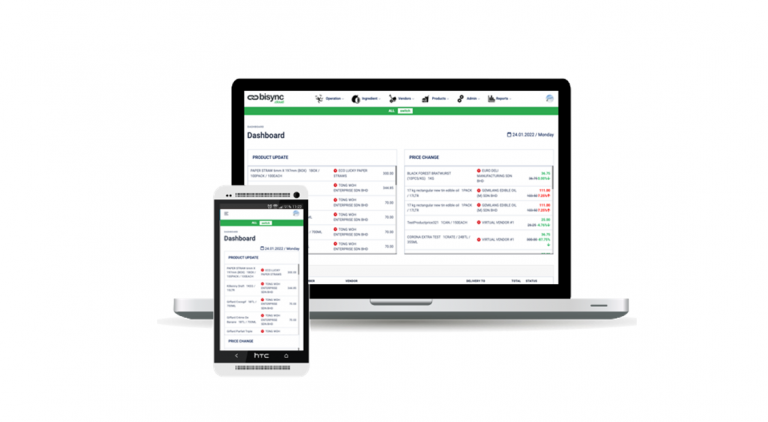Managing food is one of the major part of making a restaurant profitable. With the right tool, you can minimize food waste, manage your COGS and increase profit.
In this article, we’ll touch on
- Benefits of a good inventory management system
- Best practices in restaurant inventory management
- KPIs to help manage your inventory
What Is Inventory Management?
At its core, inventory management helps companies to manage the stock, from knowing how much to order to how the stocks are used. All restaurants have limited storage locations, and knowing the best way to maximise the storage areas and how much is needed to be profitable.
You might say that this can be accomplished with spreadsheets and manual counting, but inventory software helps to ease the process and gives you more accurate count and track your inventory. Additionally, it can show important data that alerts you when your stock reaches a certain level.
What Is Considered Inventory in a Food and Beverage Service?
Inventory for the food and beverage industry includes all the physical items needed to provide service to your customers, including food, ingredient and other items like pots and pans and employee uniforms.
Examples of inventory in a food and beverage service business include:
- Food
- Beverages
- Spices
- Cooking equipment
- Linens
- Cutleries
- Worker uniforms
Why Care About Inventory Management
A proper inventory management helps restaurants to know much stocks to keep and avoid wastages so that customers are fed and loss is kept to a minimum.
Inventory Management Benefits
In a system like Bisync, the inventory management helps you decrease food waste, gets connected to vendors across the country, decrease the overall cost of goods, increase profits and keep customers happy.
Some of the benefits include the following.
- Less food wastages:
Up to 10% of food purchased by restaurants is wasted before it even reaches the consumer. Restaurants overstocks at times and it ends up expiring before it even leaves the kitchen. Food inventory management can mitigate that loss. - Lower cost of goods:
Food costs are generally 28% to 35% of total costs for a restaurant. That goes up when food is lost or spoils. - Better vendor management:
With a centralised database, restaurants using Bisync can track the market price of multiple vendors and monitor their purchases closely, allowing them to better manage purchases and payments to vendors. - Suggestive inventory supply:
The Inventory management provides an insight into the restaurant’s inventory level, using data from the sales vs the procurement insights into a restaurant’s supply levels. The system will give you a suggestive order to purchase, so you can buy the appropriate amounts and avoids waste. - Increased profits:
The total COGS is a major component that determines net profits. Inventory management decreases waste, which lowers the COGS and ultimately increases profits.
Common ways to do Food Inventory?
Some of the more common ways to track inventory is using the same staff member to keep it consistent but manual entry like this occasionally will have stumbling blocks, ie: when the staff calls in sick or misplaced documents. Consider using an inventory management software to automate processes and ensure more accurate data and reports. Some tips for an effective inventory management include:
- A point of sale (POS) system connection.
A POS helps immensely with order planning, accounting and inventory tracking. With a system like Bisync, depletion of inventory can be automated based on your sales. Your staffs will still need to do a manual count periodically to verify and update the information on your documentation and in the inventory system. - Use the same staff .
If the same employees track inventory each time, they’ll become more efficient and can learn to spot trends or inconsistencies — but be aware of the possibility of theft if only a few employees are responsible. - Have a consistent schedule.
Stock checks should be done on a regular basis on a consistent schedule so you get an accurate count for each cycle counting. With Bisync, you can also cut down on the time needed by segregating the counting to storage locations. Plan to take inventory at the same time of day on the same day every week or month to ensure consistency. However, you can track different types of stock on different schedules. You might track more perishable food every few days and bulk or less frequently used items every week or every other week. - Follow the first expiring, first out (FEFO) inventory method.
Restaurants rely on perishable goods, so you want to use the FEFO method. That means you use the oldest food and supplies before any others. Position the oldest items in your storage areas to the front and make it easy to access. - Use your inventory to guide buying decisions.
Use the reports in Bisync to help you identify product and sales trends. Use the data to help you plan future purchases and keeping the right inventory to maximise your profits.
5 Inventory Management Best Practices
Having best practices in managing your inventory can help you manage your business more effectively.
Some key methods to help you:
Here are some best practices.
- Organize inventory:
Put labels on shelves to help staff find items quickly. It also makes restocking goods easier and quicker. Identify the most-used goods and keep them in the same, easily accessible spot. - Track all inventory:
Track every item your restaurant uses, from food and beverages to napkins and uniforms. How often you count inventory varies depending on the type of item. For example, you may track some perishable items weekly, and others, like uniforms, yearly. - Safeguard against mistakes:
Consider putting a few employees in charge of inventory and have them check each other’s work. With Bisync’s mobile app, you can easily speed up the process and track who did what in real time. - Employee accountability:
Start by training employees on how you’re tracking movement of all the inventory using a system. Allow them to be part of the solution and give them the opportunity to understand the processes in place for inventory tracking. - Use technology to forecast demand:
Use a POS or inventory management software to forecast demand based on your sales trends, seasonality and your past sales results.
Benefits of Inventory Management Systems
Inventory management software can be a big help in managing inventory for your restaurant. Among other things, the systems can offer insights into expenses and sales that manual tracking simply cannot provide. Use restaurant management systems to connect back-end financials, POS and inventory in a cohesive cloud platform.
- Real-time Inventory Management:
Inventory management when integrate with your POS can track even a single order of a meal and how that impacts your inventory. - More effective and efficient tracking:
Staff can use inventory software to efficiently and accurately track stock digitally. - In-depth reports to help decision-making:
Inventory software provides KPIs and other restaurant data that can drive better informed business decisions and increase profits.
How Bisync can Help with Inventory Management
Today’s restaurants need a system that takes inventory, tracks sales and provides other useful data about running the business to help cut costs and improve efficiency. Restaurant owners need a solution that will help them effectively manage their business and increase their profits. Whether you’re looking for a completely new inventory management system or something that will integrate into your existing setup, Bisync can help.
Bisync is a cloud based solution for restaurants, franchise and hospitality groups to increase revenue and reduce cost. Hosted on Amazon’s server, you can access the system from anywhere around the world thus helping you to manage your business even when you are on the go.
Want a demo of what Bisync can do? Drop us a message and let us know how we can help you. Schedule a 30-minute demo (you pick the date and the time), and we’ll teach you how to make F&B inventory management easier, faster and scalable.






